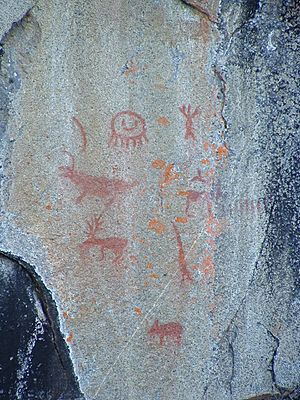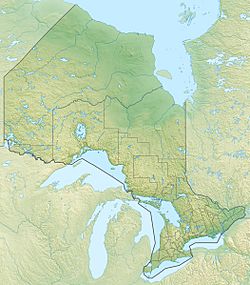Missinaibi Lake facts for kids
Quick facts for kids Missinaibi Lake |
|
|---|---|

Pictographs on Fairy Point
|
|
| Location | Ontario |
| Coordinates | 48°20′N 83°45′W / 48.333°N 83.750°W |
| Primary inflows | Little Missinaibi River |
| Primary outflows | Missinaibi River |
| Basin countries | Canada |
Missinaibi Lake is a beautiful lake located in Ontario, Canada. It's about 60 kilometers (or about 37 miles) north of a town called Chapleau. This lake is very special because it's where the Missinaibi River begins its long journey.
The Missinaibi River starts right here at the lake and flows towards the northeast. It eventually joins another big river, the Moose River. Missinaibi Lake and the rivers around it are part of a larger protected area called Missinaibi Provincial Park. You'll also find this lake right in the middle of the huge Chapleau Crown Game Preserve. Long ago, there was even a Hudson's Bay Company trading post nearby, which tells us a bit about the area's history.
Contents
Discover Missinaibi Lake
Missinaibi Lake is a large and important body of water in northern Ontario. It's known for its natural beauty and its role in the local environment. The lake is a popular spot for outdoor activities like canoeing and fishing.
Where is Missinaibi Lake?
Missinaibi Lake is found in the province of Ontario, which is in Canada. It's quite far north, in a wild and natural area. To give you an idea, it's about 60 kilometers north of the town of Chapleau. This location means the lake is surrounded by forests and wilderness.
A River's Beginning
One of the most important things about Missinaibi Lake is that it is the "source" of the Missinaibi River. Think of a source as the very beginning of a river. It's where the river starts to flow out from the lake. From Missinaibi Lake, the Missinaibi River begins its journey, winding its way through the landscape. It flows northeast and eventually empties into the Moose River, which then flows into James Bay.
Missinaibi Provincial Park
Missinaibi Lake is a central part of the Missinaibi Provincial Park. A provincial park is a special area of land and water that the government protects. These parks are set aside to preserve nature, wildlife, and historical sites. They also offer places for people to enjoy outdoor activities.
- What you can do: In Missinaibi Provincial Park, you can go canoeing, kayaking, and camping. Many people enjoy paddling the historic canoe routes that connect the lake to other rivers and lakes.
- Protected areas: The park includes the lake itself, along with parts of the Missinaibi River, Brunswick River, Brunswick Lake, Little Missinaibi River, and Little Missinaibi Lake. This helps protect a large natural area.
Chapleau Crown Game Preserve
Missinaibi Lake is also located right in the middle of the Chapleau Crown Game Preserve. A "game preserve" is a very large area where hunting is not allowed. It's a safe haven for wild animals. The Chapleau Crown Game Preserve is actually the largest game preserve in the world!
- Protecting wildlife: This preserve helps protect many different kinds of animals, including moose, bears, wolves, and various birds. Because hunting is forbidden, animals can live and thrive safely within its boundaries.
- Size: The preserve covers an enormous area, making it a vital place for wildlife conservation in Ontario.
A Glimpse into History: Trading Posts
Long ago, there was a Hudson's Bay Company trading post located near Missinaibi Lake. The Hudson's Bay Company was a very important company in Canadian history. It was involved in the fur trade, where people traded animal furs for goods like tools, blankets, and food.
- Meeting places: Trading posts were places where Indigenous peoples and European traders would meet. They exchanged furs for supplies, and these posts often became important centers of activity in remote areas.
- Historical significance: The presence of a trading post near Missinaibi Lake shows that this area has been important to people for a very long time, not just for its natural beauty but also for its resources and travel routes.


